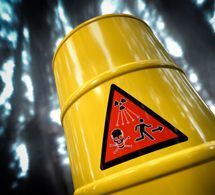Uranium mining and milling produces massive amounts of toxic waste that can contaminate air, drinking water, and pristine rivers and streams. Virtually all uranium mining in the U.S. has occurred in sparsely populated regions of the arid west, where rainfall is often below 15 inches per year. Still, according to the U.S. Environmental Protection Agency, tailings have contaminated the groundwater at almost all U.S. mill sites.
In Virginia, the toxic runoff would pose an unprecedented danger. According to the EPA, "Water is perhaps the most significant means of dispersal of uranium and related …[radioactive materials] in the environment from mines and mine wastes….Uranium is very soluble in acidic and alkaline waters and can be transported easily from a mine site." Uranium's radioactive components, particularly radium and radon, are very soluble in water, which would be a dangerous experiment for a state like Virginia with over 42 inches of rain per year.

Proponents of uranium mining acknowledge that uranium mining has had "shameful legacy in terms of human and environmental devastation." As noted by the Natural Resources Defense Council in recent comments to the Nuclear Regulatory Commission:
"The history of uranium recovery and management in the United States (and, indeed around the globe) is replete with environmental damage, serious worker safety and health abuses, and harm to entire communities….Additionally, most of the environmentally damaged sites have not received adequate cleanup of past harms, and for what little cleanup has been done, most of the cost has been borne by taxpayers rather than the companies and associated beneficiaries of the uranium mined."
In "Exposure Pathway and Health Effects Associated with Chemical and Radiological Toxicity of Natural Uranium: A Review," (2005) Dr. Doug Brugge and others at the Tufts University School of Medicine noted: "Currently, the U.S. Environmental Protection Agency (U.S. EPA) lists 23 National Priorities List (NPL) sites where uranium is a contaminant of concern …. Uranium, however, is explicitly excluded from the scoring system that is used to place sites on the NPL precluding most abandoned mines from being listed."
Health Impacts
Numerous health problems are associated with uranium and associated decay products and heavy metals. These include cancer from radon, birth defects and kidney problems from uranium, bone cancer and leukemia from radium, and lung and skin cancer from arsenic.
According to the EPA website "There are four principal ways (or exposure pathways) that the public can be exposed to the hazards from this waste."
- "The first is the diffusion of radon gas directly into indoor air if tailings are misused as a construction material or for backfill around buildings. When people breathe air containing radon, it increases their risk of developing lung cancer."
- Second, radon gas can diffuse from the piles into the atmosphere where it can be inhaled and small particles can be blown from the piles where they can be inhaled or ingested."
- "Third, many of the radioactive decay products in tailings produce gamma radiation, which poses a health hazard to people in the immediate vicinity of tailings."
- "Finally, the dispersal of tailings by wind or water, or by leaching, can carry radioactive and other toxic materials to surface or ground water that may be used for drinking water."
In 2007, the Colorado Medical Society resolved that it "opposes the practice of in-situ and open pit mining of uranium due to the adverse health impact of radioactively contaminated water on our agriculture, livestock and civilian population." In his 2007 testimony before Congress, Dr. Brugge described "uranium ore … [as] a toxic brew of numerous nasty hazardous materials."
